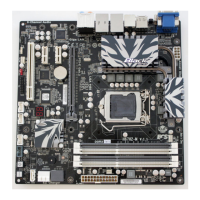
Do you have a question about the ECS H67H2-M and is the answer not in the manual?
| Form Factor | Micro ATX |
|---|---|
| Socket | LGA 1155 |
| Chipset | Intel H67 |
| Memory Type | DDR3 |
| Max Memory | 32GB |
| Expansion Slots | 1 x PCIe x16, 1 x PCIe x1, 2 x PCI |
| Storage Interfaces | 4 x SATA 3Gb/s, 2 x SATA 6Gb/s |
| LAN | Gigabit Ethernet |
| USB Ports | 4 x USB 2.0, 2 x USB 3.0 |
| Video Outputs | VGA, DVI, HDMI |
| Audio | Realtek ALC892 |
Legal notices regarding copyright, disclaimer, and trademarks.
Federal Communications Commission (FCC) compliance statement.
Overview of motherboard features and components.
Guide to installing motherboard components and safety.
Instructions for navigating and configuring the BIOS setup.
Procedures for installing drivers and utilities.
Steps to install and configure the eJIFFY fast boot feature.
Guide to configuring RAID sets using Intel Matrix Storage Manager.
Common system start-up and operational problems and solutions.
General introduction and key features of the motherboard.
Detailed technical specifications of the motherboard.
Identification and description of motherboard components.
Essential safety guidelines for motherboard installation.
Guidelines for case selection and physical motherboard installation.
Details on processor, chipset, memory, and audio features.
Information on Gigabit LAN and available expansion slots.
Details on integrated I/O ports and BIOS firmware features.
Specifications for CPU, Chipset, and expansion slots.
Specifications for memory, storage, LAN, and rear panel I/O.
Specifications for internal I/O connectors and headers.
Information on System BIOS features and motherboard form factor.
Explanation of the BIOS Setup Utility's purpose and functions.
Procedure for accessing the BIOS setup utility during system boot.
How to reset BIOS settings to factory defaults.
Key navigation controls and main menu structure of the BIOS.
Configuration options within the Advanced BIOS menu.
Settings for onboard LAN controller and eJIFFY feature.
Monitoring system temperatures, voltages, and fan speeds.
Settings for CPU fan speed control and system power management.
Details and settings for CPU features and operation.
Settings for selecting SATA mode (IDE, AHCI, RAID).
Settings for USB ports, controllers, and TPM support.
Configuration options for North and South bridge chipsets.
Settings for clock speed, system bus, and CPU performance tuning.
Settings for boot device priorities and NumLock state.
Options for setting administrator and user passwords.
Procedures for saving changes and exiting the BIOS setup.
Step-by-step guide to downloading and installing BIOS updates.
Description of software and drivers provided on the support disc.
Procedures for installing drivers and utilities automatically or manually.
Overview and activation process for the eJIFFY fast boot feature.
Steps to install, configure, and use the eJIFFY interface.
Preparation steps and items needed before creating a RAID set.
Procedure to enter the Intel Matrix Storage Manager RAID BIOS utility.
Step-by-step guide to creating and deleting RAID volumes.
How to revert disks from RAID configuration to Non-RAID.
Solutions for system power and display issues during assembly.
Troubleshooting steps for issues after extended system use.
A visual guide to diagnose and resolve system issues.
